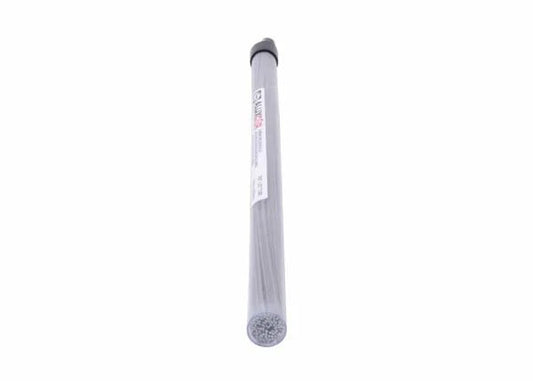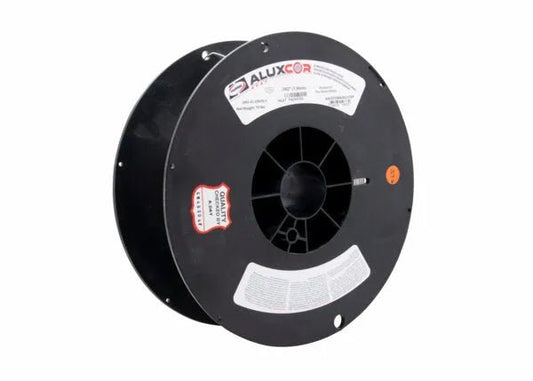Factors to Consider When Choosing a Brazing Alloy
Brazing requires that the filler metal flow into a capillary between the two closely aligned base metals to be joined. In the case of copper-phosphorus braze alloys - these base metals are usually copper or brass, and joint integrity is dependent on a number of factors in addition to the choice of filler metal.
Phos-copper, and phos-copper-silver brazing alloys - such as Harris Stay Silv® alloys, Dynaflow® and Blockade® - are used for joining copper, brass and bronze only. You never want to join steel, cast iron or stainless steel with a phosphorus containing braze alloy; simply put the connection provides limited strength.
Medical gas copper oxygen line installations to NFPA 99 require using a phos-copper BCuP brazing alloy conforming to AWS A5.8 without flux. A nitrogen purge is also required during brazing. For copper to brass applications a flux is required. For these connections apply the flux sparingly to avoid getting flux inside the lines.
Other environments such as boiler houses, paper mills, and natural gas lines have high concentrations of sulfides or sulfur. Sulfides attack the phosphorus in the phos copper brazing alloy and can result in leaks. When joining material exposed to a sulfur environment you should use a high silver brazing alloy such as Harris Safety Silv®.
The temperature at which the filler metal flows and the skill of the operator in adding filler metal at the correct temperature are important. Proper cleaning of the base metal before brazing and avoiding excess oxidation during heating are contributing factors in joint integrity.
All of the factors that contribute to joint integrity must be properly controlled to assure reliability of a brazed joint.
Brazing Flux 101
A chemical flux is commonly used with many braze filler metals. Proper fluxing is important because the flux absorbs oxides formed during heating and promotes the flow of filler metal. Fluxes are chemical mixtures that contain varying chemical components. The mixture is blended to ensure smooth application and adherence.
Ever wonder about the different flux types and where each is used? Here's a crash course that explores the types of silver brazing flux we manufacture:
Stay-Silv® White Brazing Flux
This is a white paste flux that's used for 90% of silver brazing applications. White flux is useful for brazing copper, brass, steel, stainless steel, and nickel alloys. It has an active temperature range of 1050 -1600°F (565 - 870°C). Use it with the Safety-Silv® high silver brazing filler metals (AWS BAg series) on the above base metals, and the Stay-Silv® phos-copper-silver (AWS BCuP series) on copper to brass.
White flux conforms to American Welding Society (AWS) specification A5.31; class FB3-A, and Aerospace Material Specification (AMS) 3410.
Stay-Silv® Powder Brazing Flux
Hot-rodding a brazing rod with powder flux
This is similar to the white flux except in a powder form. Because it's a powder it will not separate or harden during storage (keep lid tightly closed as the flux will draw moisture from the air). The flux can be used in its powder form by heating the end of the brazing rod or wire and dipping it in the flux. This is sometimes called "hot rodding". The flux will adhere to the heated rod. The flux can also be mixed as needed with water or alcohol to form a paste, which can then be applied to the part prior to brazing.
This flux conforms to AWS A5.31 class FB3-F and has a temperature range of 1200 - 1600°F (650 - 870°C).
Dynaflow® Auto Dispensing Flux
Flux application can be automated on brazing machines using dispensing equipment. For automated flux dispensing mixture, particles must be held below a minimum size to prevent clogging orifices and lines. Dynaflow flux was originally developed as a "smoother" flux to facilitate automated feeding. This consistency is developed by introducing an additional step during the manufacturing process. The smoother consistency also reduces fluid separation inside unused containers.
Dynaflow Flux is used for similar brazing applications as the standard white flux.
Stay-Silv® Black Brazing Flux
Pipe fitting with Stay-Silv® Black Brazing Flux
The black flux formula includes powdered boron which gives the flux a black color (really more brown – but "brown" brazing flux doesn’t have the same panache). This ingredient provides two features:
a. Flux absorbs oxide during heating. There is a maximum amount of oxide absorption the flux provides, after which it becomes saturated and is no longer effective. This formulation allows the flux to withstand longer heating cycles without breaking down. These applications may include specific types of concentrated localized heating (induction, for example), or may occur during torch heating of large parts. In these cases the black brazing flux is a good choice.
b. Some metal oxides are more difficult to flux. These include stainless steel, nickel alloys, and tungsten carbide. The black flux helps dissolve these oxides and assists in filler metal wetting.
Black flux is primarily used with the Safety-Silv high silver brazing filler metals (you’ll often find it used with the nickel containing 40Ni2 or 50N products). It conforms to AWS A5.31 class FB3-C and AMS 3411 and has an active temperature range of about 1050 - 1700°F (565 - 925°C).
ECO SMART® Flux
Boric acid is a component of many brazing flux mixtures. The European Union’s REACH (Registration, Evaluation, Authorization, and Restriction of Chemicals) regulation notes that boric acid is categorized as a "Substance of Very High Concern" based on test data indicating it may be a reproductive toxin.
ECO SMART Flux formulation has the following benefits:
ECO SMART® Green Brazing Flux applied to copper pipe
a. Provides a boric acid free flux formulation to remove the boric acid component and promote use of a safer brazing flux.
b. A green color that turns clear or transparent close to brazing temperature. This makes it easier for the operator to gauge when to apply the braze filler metal.
c. Is available in several formulations to meet every brazing need:
1. Green Paste – for standard brazing applications (similar to Stay-Silv white flux and used with the same filler metals and applications).
2. Green Powder – in powder form.
3. Black Paste – boron modified flux for longer heating cycles and difficult to braze base metals (similar to Stay-Silv black flux and used with the same filler metals and applications.).
4. Black Powder – boron modified flux in powder form.
FAQ's Brazing
Procedures for Soldering
Soldering is a joining process wherein coalescence is produced by heating below 800°F, using a non-ferrous filler metal with a melting point below that of the base metal. The metals to be joined dictate the flux, solder, and heating methods to be used. Base metals are selected for specific properties such as electrical conductivity, weight, and corrosion resistance.
To achieve a sound soldered joint, the following should be considered:
- Joint design: They should be designed with the requirements of solders and their limitations in mind.
- Pre-cleaning: The surfaces must be thoroughly cleaned to allow the solder to wet the base metal.
- Fluxing: A flux must be provided to remove traces of surface film or oxides and to prevent formation of oxides during the soldering operation.
- Proper fixtures or alignment of parts must be maintained to insure a sound soldered joint.
- Heating of the base metals should be uniform or even on base metals, to insure good penetration of the filler alloy into the joint. If a noncorrosive flux is used no further cleaning is necessary. The use of a corrosive flux makes flux residue removal imperative.
Basic Steps of Soldering
1. Joint fitting: A clearance of 0.005" is suitable for most soldering. When soldering precoated metals, a clearance of 0.001" is recommended for maximum mechanical strength.
2. Types of cleaning include:
- Mechanical - Scotch Brite pad, emery cloth
- Chemical - cleaning using acids to remove rust, scale or sulfides. Most commonly used acids are hydrochloric and sulphuric.
3. Application of flux
- Flux should be capable of removing oxides and stop them from reforming.
- Flux should permit displacement by the solder.
- Flux should promote wetting of the surface by the solder.
4. Application of heat: Heating the joints evenly or uniformly is of utmost importance to insure a sound joint.
- Types of soldering equipment:
- Soldering irons - electric
- Plumbers torch - propane low heat
- Dip soldering - large tank with molten solder to solder multiple joints
- Oven heating - only used in production where other heating methods are impractical
5. Applying the Solder takes place in two steps:
- Wetting the metal surfaces
- Filling the gap between the wetted surfaces with solder
Depending upon conditions dictated by the application, each step can be done separately. This allows for more easily controlled conditions.
6. Cooling the Joint:
- As soon as possible after soldering the joint may be cooled using a water spray or air blast. Slow cooling could cause excessive alloying, resulting in a brittle joint.
7. Flux Residue Treatment:
- Non-corrosive fluxes are ones which are rosin base and do not require removal. Corrosive fluxes are fluxes containing zinc chloride. Removal is a must to prevent corrosion
Featured Products
What is Silver Brazing Flux
To ensure the best connections, The Harris Products Group produces a wide variety of flux products designed for specific applications throughout a number of different industries. The most common are Stay Silv® White and Stay Silv® Black flux.
Stay Silv White brazing flux is a general purpose silver brazing flux in paste form. It has an activation range of 1100°F to 1600°F. The white flux is primarily used in manual brazing applications. This flux conforms to American Welding Society, (AWS), A5.31 class FB3-A.
White brazing flux is also available in a powder form and as flux coated braze rods. With powder flux the heated rod is dipped into the flux. The flux adheres to the heated surface for transfer to the work piece. Flux coating the rod provides a convenient method of applying flux. Both the powder and the flux coated rod form also minimize the amount of flux applied to the assembly.
Stay Silv Black paste flux has the same performance characteristics as the Stay Silv White flux. However Stay Silv Black flux has a higher activation range 1100°F to 1800°F. This higher activation range allows the flux to be used during longer and higher temperature heat cycles, such as with induction brazing. It’s also suitable when brazing stainless steel and nickel alloys. Black flux conforms to AWS A5.31 Class FB3-C.
Harris Dynaflow® flux is a thoroughly homogenized flux designed for automated flux dispensing systems. The smoother consistency reduces the chance of clogging small dispensing orifices.

















